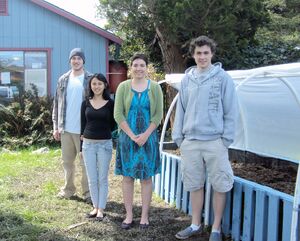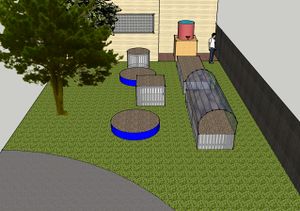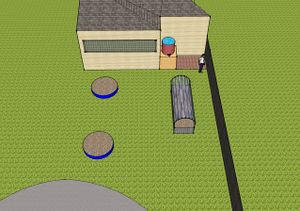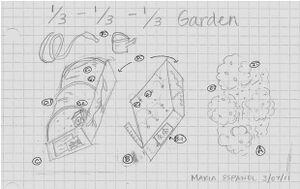



Abstract
Sprouting Education is a group of students from Humboldt State University partaking in a design project in Engr215 Introduction to Design, to create a garden for elementary school use. The team of four were given 3 months to complete the design project in five distinct sections. Sprouting Education's team members were introduced to the many unique challenges and experiences associated with designing a solution from a given problem. The team decided on building a variety of gardens in order to provide examples of the diverse flora available to most regions.
Background
Locally Delicious is a group of women determined to beat corporate agricultural by helping the nation eat more healthy and locally. For their book Lunchbox Envy, Locally Delicious continue their battle, focusing on getting students across the nation to eat healthier by getting students in touch with where their food comes from. Sprouting Education formed in the Environmental Engineering Design class at Humboldt State University in Spring 2011 to design a school garden for Locally Delicious' Lunchbox Envy book. Sprouting Education has designed a school garden for grades 4-8 which can teach kids the benefits of growing and eating their own food. The garden is inexpensive and simple to construct, making it a versatile design that can be implemented in schools across the nation. The variety of garden beds displayed in the design allow schools to choose which bed or combination of beds are appropriate for their site.
Project Statement
The objective of Sprouting Education was to design and build an interactive school garden for students to learn the benefits and values of sustainable agriculture. The final design encourages students to eat healthier by empowering them to produce their own food.
Project Criteria
| Criteria | Description | Weight |
|---|---|---|
| Learning Potential | The ability to convey educational concepts from the garden to students | 10 |
| Participant Safety | Students will be protected from any hazardous structure from the garden | 10 |
| Reproducibility | The design of the garden is easily reproduced and transferable by others | 9 |
| Child Appeal | The aesthetics attract students to the garden | 8 |
| Cost | Reasonable price for overall material and labor | 8 |
| Sufficient Produce | The potential to produce enough produce for students to find the garden rewarding | 7 |
| Easy Maintenance | Simplicity to maintain the garden during the summer and school year | 6 |
| Plant Safetey | Plants will be protected from any harm or destruction | 2 |
| Expandability | The design of the garden is accessible for any additional expansion | 1 |
Final Project Design
The final project design is a collection of different styles of gardens which will entertain and enlighten kids about the benefits of local agriculture. Trillium Children's Garden is composed of a variety of three garden aspects, the rainwater catchment system, kiddie pool garden, and pallet garden with greenhouse top. The rainwater catchment system is simply a pickle bin posted beneath the gutter of the school which catches and stores rainwater for treating the garden. The raised bed is a 4 X 12 ft garden made of half-cut wooden pallets and geotextile fabric against the inner perimeter of the pallets to secure the soil in place. On top of the raised bed are PVC pipes bent across, outlining the structure for the greenhouse top to lie in place. The plastic sheeting serves as our green house top sheeting which is simple laid over the pipes and locked down in place with bungee hooks. A wooden dowel is attached to the ends of the plastic sheeting. These dowels provide as a tool for one to easily roll up the sheeting to the top of the hoop, help up by clamps, so one can work in the garden. The two Kiddie-Pools will be filled with soil as its own transferable garden. Diagrams will be scattered around the garden to illustrate concepts such as the plant life cycle and the process of photosynthesis to educate the kids about the science behind their garden.
Installation
- Installation
Costs
The costs involved in creating the Sprouting Education Garden come in two forms: hours of labor and materials costs.
Design Hours
The chart to the right shows the breakdown of design hours that went into constructing the Sprouting Education School Garden. A majority of the hours were spent in the construction phase.
Building and Materials Costs
Below are the costs of materials to construct the garden. The total building and design costs without donations were $697.34. A local Lacies factory donated the wooden pallets we needed and Pierson's Building Center donated a hose, 5 12' PVC Pipes, A 50 Gall. Pickle Barrel, 48' Rebar bringing the group’s total cost to only $270.63.
| Materials | Quantity | Cost Per Quantity $ | Our Cost $ | Potential Cost $ |
|---|---|---|---|---|
| Sand Paper-Grade 80 | 2 | 1.19 | 1.19 | 2.57 |
| U-Clamps | 20 | 1.33 | 26.60 | 26.60 |
| 12' rebar | 4 | 8.99 | 0.00 | 35.96 |
| 50' Hose | 1 | 16.99 | 16.99 | 16.99 |
| 50 Gal. Pickle Barrel | 1 | 30.00 | 0.00 | 30.00 |
| Wooden Pallets | 16 | 19.50 | 0.00 | 312.00 |
| 100x10 Ft Geotextile fabric | 1 | 30.00 | 0.00 | 30.00 |
| Plastic Cover | 1 | 8.88 | 8.88 | 8.88 |
| Screws per lb | 1 | 3.59 | 3.59 | 3.59 |
| 1" Diameter 12' PVC Pipe | 5 | 1.05 | 0.00 | 5.25 |
| Bungee Cord Mini 10" 8 pack | 1 | 6.82 | 6.82 | 6.82 |
| Washer | 1 | 1.34 | 1.34 | 1.34 |
| Thermometer (Wall) | 1 | 2.96 | 2.96 | 2.96 |
| Drill Bit 1-1/8" | 1 | 4.29 | 4.29 | 4.29 |
| Metal Strap | 1 | 2.06 | 2.06 | 2.06 |
| Couple Hose Nylon Shut Off | 1 | 3.86 | 3.86 | 3.86 |
| PVC Adapter | 1 | 1.79 | 1.79 | 1.79 |
| Flew Jaw Spring Clamp 6" | 2 | 1.50 | 3.00 | 3.00 |
| Paint (Pilgrim Blue) | 1 | 31.98 | 31.98 | 31.98 |
| Paint (Off Tint) | 1 | 15.00 | 15.00 | 15.00 |
| Poly Paint Brush Set | 1 | 5.99 | 5.99 | 5.99 |
| Soil 1-1/2 Cu Yds | 1 | 60.00 | 0.00 | 60.00 |
| Gas | 1 | 150.00 | 150.00 | 150.00 |
| Total Costs | 270.63 | 697.34 |
Expected Maintenance Costs
The system was designed to require as little maintenance as possible, although normal garden maintenance will need to be upheld to guarantee the success of the garden.
| Task | Time (hrs/wk) |
|---|---|
| Water Garden | 2.0 |
| Weeding Garden | 1.0 |
| pH and Nutrient Top-Off | 0.5 |
| Soil Tilling | 0.5 |
| Total Time | 4.0 |
Testing Results
Trillium Charter School’s Earth Day on April 22nd, was the day kids tested our design by planting seeds in our garden. Prior to actual seeding, the students were able to gather together, un-hook and roll up the plastic sheeting (green house top) to the top of the raised bed in order to start tending the garden. Each child had a seed to plant in our pallet raised bed garden and watered the seeds using our rainwater catchment system. After watering, the kids were capable of rolling down the plastic sheeting down on their own and hooking them back into place.
Building and Implementation Instructions
Materials For A 4'x12' Pallet Garden Box with Green House top
- 4 shipping pallets in uniform shape and design, and around 4’X4’ dimensions (these can be collected for free from dumpsters behind many businesses that ship or receive large inventories)
- 12 pieces of 3’ long rebar
- 7 PVC pipes -12’ long 1/2” diameter
- 12 u-clamps that fit over the PVC pipe
- Geotextile fabric, enough to line the inside of the garden bed, about 104 sq. ft.
- 1 12’ X 12’ sheet of plastic sheeting, the 3 mil. Clear painting tarps will do
- 1 gal. non-toxic weatherproof stain
- As many paintbrushes as painters can be recruit
- sponges
- A nice stash of screws, varying in ¼” to 2” in length
- 12 pieces of salvaged 2’ X 4’ wood at least 18” long
- 1 staple gun with supply of staples
- 1 large sledge hammer or mallet
- 1 power drill
- 1 skill saw
- Sand paper
- Shovels
- Tape measure
- Enough soil to fill the 11’ X 4’ X 2’ garden bed
- 2 pinch clamps that will fit over the PVC Pipe diameter
- 8 bungee chords
Building A 4'x12' Pallet Garden Box with Green House Top
- Check pallets to ensure they are not treated with chemicals. The following website gives a good guide on which pallets contain chemicals: http://www.palnetusa.com/a/global-domestic-pallet-standards/intl-pallet-standards/what-every-buyer-needs-to-know.tpl
- Measure and cut pallets in half perpendicular to their slats as shown in figure 1. This step should result in 8 similar looking halves. Don’t worry about minor unevenness, which will get sorted out later. Now, sand all large splinters off of the pallets using coarse grade sand paper.
Figure 2 Measuring and Cutting Pallets
- Using weather resistant wood stain, paint all the surfaces of the pallets to keep them from rotting. The hard to get spaces between the faces of the slats can easily be painted with sponges. Painting and sanding are great activities for students to help with.
Figure 3 Painting cut pallets
- Take pallets to desired location and arrange them in a 1x3 pallet-halve rectangle. This is the perimeter of the garden. Connect and secure the pallets to each other by screwing salvaged 2x4” pices of wood at the joints. To join side panels and even out the tops of the pallets, place a piece of wood underneath the top trim and secure to both pallets (this should also hide the 2x4 nicely). To join corners, cut 2x4’s to the same height as the pallets. Place the wood vertically on the inside or outside of the corner, and screw it into both corner pallets as shown in figure 4.
Figure 4 Corner and Side Joints
- Paint the new wood additions as well as any other touchups on the frame. While the paint dries, reinforce the frame with rebar. The rebar will keep the frame from bulging under the pressure of the soil when it is filled. Pound a total of 4 rebar steaks into the ground along the outside of each length of the frame. Rebar should be placed at every corner joint of the two long sides as shown in figure 5. Rebar can easily be pounded into the ground using a 2’ capped metal pipe and a large hammer as shown in figure 5. Hold the rebar in place and slide the metal pipe over it. Pound the metal pipe until the bottom of it touches the ground (this method insures that all rebar is pounded 1’ into the ground). Remove the metal pipe and repeat for all the rebar.
Figure 5 Pounding in Rebar
- Also place 2 rebar steaks into each of the end pallets. To do this, decide on two places in the pallet to set the rebar where it will be hidden from site. Drill holes through the pallet supports, and pound the rebar through the holes until the top of the rebar is flush with the top of the pallet.
- Bend on length of PVC pipe and place over two rebar steaks that are across from each other. PVC pipe is easily bent by having 2 people, one person holding each end of the pipe, walk towards each other until the pipe is bent enough to fit over the rebar. Slide the PVC over the rebar until it touches the ground.Repeat this step until all 4 sets of side rebar are holding a PVC Pipe.
- Now secure each pipe to the pallet frame by placing a u-clamp over the pipe, about 2 inces below the top of the pallet. Screw the clamps down with appropriate screws. Repeat this step until all 8 ends of PVC are secured. The end result of step 6 should look like Figure 6.
Figure 6 Completed Frame
- Test the Geotextile or landscaping fabric to see if it is permeable to water in only one direction; if so, place this side of the fabric up. Line the inside of the garden bed with the fabric, again making sure that water will be able to drain out of the garden. Fabric can easily be staple-gunned to the top of the frame. While securing the fabric, remember to leave enough slack in the fabric for it to reach to bottom corners and also to keep a nice flat surface along the edges so that shovels and little hands don’t get caught in the wrinkles as shown in figure 7.
Figure 7 Geotextile lining
- Once the frame is lined with fabric, fill it with soil. A low-quality dirt can be used to fill the bottom, but for the top choose a fertile soil suitable for the plants planned on growing.
- To finish the green house frame, place a piece of PVC pipe underneath the tops of the hoops. This will become the supporting pipe. While two people hold the pipe in place, a third person can screw a u-clamp over each hoop and into the supporting pipe. There should be about 6” of pipe sticking out on both ends of the garden.
- Cut a 12x12 piece of 3 mil. plastic. At two opposing ends, place a the last two PVC pipes flush with the edge of the plastic. Using a staple-gun, staple the plastic to the pipe. Roll the plastic over the pipe once or twice and staple it down again. Staples should be 2-3” apart, so that the plastic is well secured to the pipes.
- Now lay the plastic over the hoop frame evenly and secure the plastic to the supporting PVC pipe with a pinch clamp on each end, as shown in figure 8.
Figure 8 Securing Plastic
- To secure the bottom of the plastic, drill 4 evenly spaced holes into each pipe wrapped in plastic (1 at each end of the pipe, and 2 in the middle). Hook 1 end of each bungee cord into each of the holes. Tug on each bungee cord to decide where it should connect to the frame to keep the plastic taught. Screw in screws at the appropriate place, but let the screws stick out about ¼”. Hook the loose end of the bungee cord to the screw as shown in figure 9.
Figure 9 Bungee Cord Holding Down Plastic Now the garden is ready to plant!
Discussion
By including reusable materials, interactive mediums, and educational displays, Trillium Children’s Garden inspires students to grow their own food and eat healthy. Schools across the nation will be able to create a school garden, by recreating our simple and sustainable garden design. The design’s easy implementations and use of reusable materials will encourage school’s to start building a garden for their students, leading them the path of learning and experiencing sustainable agriculture.